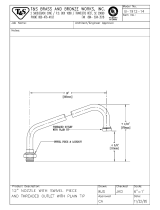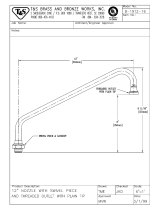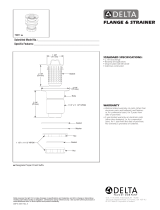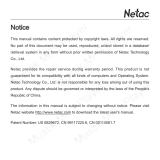Page is loading ...

Operating limits and replacement intervals
The recommended replacement intervals and the corresponding operating limits in chapter 3 are jointly defined
with the enginebuilder. This information is specific to the product.
Non-observance of the recommended replacement intervals and the operating limits increases the risk of unpre-
dictable component failures.

Operation Manual / 1 Introduction
T
able of contents Page 1 /
8
© Copyright 2016 ABB. All rights reserved.
HZTL4005_EN
Revision E
July 2016
Introduction
1
Introduction ............................................................................................
3
1.1
Purpose of the manual ...............................................................................
3
1.2
Symbols, definitions ...................................................................................
4
1.3
Storage of new turbochargers and spare parts ..........................................
6
1.4
Contact information ....................................................................................
8


Operation Manual / 1 Introduction
1
Introduction
Page 3 /
8
© Copyright 2016 ABB. All rights reserved.
HZTL4005_EN
Revision E
July 2016
1 Introduction
1.1 Purpose of the manual
Figure 1: Serial number (01) on the rating plate
This Operation Manual belongs to the turbocharger with the identical serial number (01), see
chapter 3 (Safety data sheet) and the rating plate on the turbocharger.
Operation Manual
The Operation Manual explains the turbocharger and contains instructions for safe operation.
The Operation Manual is a complement to and expansion of existing national regulations for
occupational safety, accident prevention and environmental protection.
Target group
The Operation Manual is aimed at engineers and trained mechanics responsible for the proper
operation of the engine and for the turbocharger connected to it.
Availability of the Operation Manual
The Operation Manual must be available where the turbocharger is used.
All persons operating or working on the turbocharger must have read and fully understood the
Operation Manual.

Operation Manual / 1 Introduction
1
Introduction
Page 4 /
8
© Copyright 2016 ABB. All rights reserved.
HZTL4005_EN
Revision E
July 2016
1.2 Symbols, definitions
Symbols
The following symbols are used in this document:
Shows an action.
1. Shows a numbered action.
Enumeration, first level
– Enumeration, second level
[➙ ] Refers to a page number
Definition of Note
NOTICE
Note
The note provides advice which facilitates the work.
Definition of mandatory signs
Mandatory signs show the protective equipment to be worn for a task. The mandatory signs
are described in chapter Safety and must be complied with.
Definition of Caution / Warning
Caution and warning signs are described in chapter Safety.
ABB Turbo Systems
ABB Turbo Systems Ltd is identified as ABB Turbo Systems in this document.
Official service stations of ABB Turbo Systems
Official service stations are identified in this document as ABB Turbocharging Service Sta-
tions. They are regularly audited and certified by ABB Turbo Systems. Also see chapter Con-
tact information [➙ 8].

Operation Manual / 1 Introduction
1
Introduction
Page 5 /
8
© Copyright 2016 ABB. All rights reserved.
HZTL4005_EN
Revision E
July 2016
Definition of pictograms
The following pictograms can occur in this document. These point out actions that must be
taken in accordance with the meaning of the relevant pictogram.
Pictogram
Meaning
Pictogram
Meaning
Tighten with specified torque
Affix
Tighten over specified tightening
angle
Measure
Hand-tight, tighten without tools
Note
Oil
Visually inspect
Apply screw locking paste (e.g.
Loctite)
Please note text for numbered
work step.
Apply high-temperature grease
See document
Apply other paste in accordance
with specifications
Dispose of in an environmentally
compatible, professional way and
in compliance with locally applica-
ble regulations.
Oil free, grease free and dry
Table 1: Definition of pictograms

Operation Manual / 1 Introduction
1
Introduction
Page 6 /
8
© Copyright 2016 ABB. All rights reserved.
HZTL4005_EN
Revision E
July 2016
1.3 Storage of new turbochargers and spare parts
Storage of new turbochargers and spare parts for up to 6 months
New turbochargers and spare parts can be stored in their closed packages for 6 months from
the date of delivery without additional mothballing measures, indicated by VCI label on package.
Figure 2:
V
olatile
C
orrosion
I
nhibitor (VCI)
Only dry rooms with 40...70 % atmospheric humidity, in which no water condensation can
form, are suitable as storage locations.
Storage of new turbochargers and spare parts for more than 6 months
WARNING
Health protection when handling VCI
VCI products are not hazardous in terms of the Ordinance on Hazardous
Substances. Nevertheless, the following points must be observed when
handling VCI:
Observe the information in the material safety data sheet.
Ensure proper space ventilation.
Do not eat, drink or store food at the workplace while working with VCI.
Clean hands and face after working with VCI.
For more information, see www.branopac.com.
Wear safety gloves to protect against mechanical hazards.
Every 6 months, the following mothballing measures are required:
Open package.
Remove VCI corrosion protection emitter from package and replace with a new VCI corro-
sion protection emitter of the same kind. New VCI corrosion protection emitters can be ob-
tained from www.branopac.com.
Old VCI corrosion protection emitters must be disposed of in an environmentally compati-
ble, professional way and in compliance with locally applicable regulations.
Close package. The more tightly the package is sealed, the longer the protection duration.

Operation Manual / 1 Introduction
1
Introduction
Page 7 /
8
© Copyright 2016 ABB. All rights reserved.
HZTL4005_EN
Revision E
July 2016
Long-term storage of replacement turbochargers or spare parts
If requested in the purchase order, the turbochargers or cartridge groups will be prepared for
long-term storage. The package is equipped with a hygrometer (see illustration).
Figure 3: Package with hygrometer
Every 6 months, the following measures are required:
Check the hygrometer (02) in the sight-glass. There is an opening (01) in the wooden crate
to enable you to perform this check. If the 70% indicator field has changed colour, the
maximum admissible atmospheric humidity has been exceeded. In this case, the turbo-
charger or cartridge group must be checked and repackaged by an ABB Turbocharging
Service Station.
Check the package for damage. If the package is damaged, the turbocharger or cartridge
group must be checked and repackaged by an ABB Turbocharging Service Station.
After every 3 years, the following steps must be carried out by an ABB Turbocharging Service
Station:
Checking the component
Replacing the desiccant
Repackaging the component.
NOTICE
Replacement components which are ready for operation
If the 70% field of the hygrometer (02) has not changed colour and the
package is not damaged, the replacement turbocharger or replacement car-
tridge group can be put into operation without previously having been
checked by an ABB Turbocharging Service Station.
Unpackaging replacement turbochargers or spare parts
Once the material has been unpackaged from the VCI package, the corrosion protection is no
longer effective.
To prevent condensation, the temperature of the package contents must be the same as the
ambient temperature.

Operation Manual / 1 Introduction
1
Introduction
Page 8 /
8
© Copyright 2016 ABB. All rights reserved.
HZTL4005_EN
Revision E
July 2016
1.4 Contact information
Contact information of the ABB Turbocharging Service Stations is available online.
Scan the QR code to access our website.
ABB Turbo Systems Ltd
Bruggerstrasse 71a
CH-5401 Baden
Switzerland
www.abb.com/turbocharging

Operation Manual / 2 Safety / A130 - A155
Table of contents
Page 1 /
19
© Copyright 2017 ABB. All rights reserved.
HZTL4022_EN
Revision D
January 2017
Safety
1
Safety ........................................................................................................
3
1.1
Introduction ..................................................................................................
3
1.2
CE conformity ..............................................................................................
3
1.3
Definition of mandatory signs ......................................................................
4
1.4
Definition of safety instructions ....................................................................
4
1.5
Intended use ................................................................................................
5
1.6
Deflagration on gas engines ........................................................................
6
1.7
Warning plates on the turbocharger ............................................................
7
1.8
Turbocharger rating plate ............................................................................
8
1.9
Periodic check of the pressure vessels .......................................................
9
1.10
Lifting of loads .............................................................................................
10
1.11
Prerequisites for operation and maintenance ..............................................
11
1.12
Hazards during operation and maintenance ...............................................
12
1.13
Safe operation .............................................................................................
14
1.14
Safe maintenance .......................................................................................
16


Operation Manual / 2 Safety / A130 - A155
1
Safety
Page 3 /
19
© Copyright 2017 ABB. All rights reserved.
HZTL4022_EN
Revision D
January 2017
1 Safety
1.1 Introduction
Turbochargers manufactured by ABB reflect the state of the art. The respective safety and
health protection requirements are met. This ensures safe operation of the turbocharger. Nev-
ertheless, there may be some residual risks during operation of and work on the turbocharger
which:
Are caused by the turbocharger itself or its accessories.
Are caused by the operating equipment used or supplies and materials.
Are a consequence of insufficient compliance with safety instructions.
Are a consequence of insufficient or inappropriate performance of maintenance and in-
spection work.
The operating company is responsible for defining measures that regulate safe access to and
safe handling of the turbocharger.
All instructions contained in this chapter must be observed for safe and trouble-free operation
of the turbocharger and during all work on the turbocharger.
All further safety instructions contained and specifically identified in every chapter of this man-
ual (Definition of safety instructions [➙ 4]) must also be observed.
1.2 CE conformity
Information
ABB turbochargers comply with the Machinery Directive 2006/42/EC and are partly completed
machinery as defined by Article 2 g in this directive.

Operation Manual / 2 Safety / A130 - A155
1
Safety
Page 4 /
19
© Copyright 2017 ABB. All rights reserved.
HZTL4022_EN
Revision D
January 2017
1.3 Definition of mandatory signs
To be worn at all times
Protective clothing
Safety footwear
to protect against
mechanical hazard and risk of fall-
ing
Table 1: Personal protective equipment to be worn at all times
To be worn specific to the respective task
Safety glasses
Safety goggles
Safety gloves to protect against
- Mechanical hazard
- Chemical hazard
- Thermal hazard
Respiratory mask to protect against
- Dusts
- Gases
Safety helmet
Ear protection
Table 2: Personal protective equipment to be worn specific to the respective task
1.4 Definition of safety instructions
WARNING
Definition of Warning
Non-compliance or inaccurate compliance with working or operating instruc-
tions indicated by this symbol and the word
WARNING
can lead to serious
injuries to personnel and even to fatal accidents.
Warning signs must always be observed.
CAUTION
Definition of Caution
Non-compliance or inaccurate compliance with working or operating instruc-
tions indicated by this symbol and the word
CAUTION
can lead to serious
damage to engine or property with grave consequences.
Caution signs must always be observed
.

Operation Manual / 2 Safety / A130 - A155
1
Safety
Page 5 /
19
© Copyright 2017 ABB. All rights reserved.
HZTL4022_EN
Revision D
January 2017
1.5 Intended use
Use on internal combustion engines in general
ABB turbochargers are intended for turbocharging internal combustion engines.
To ensure compliance with the machinery directive 2006/42/EC when using on gas engines,
the turbocharger must be operated in an engine room classified as "not at risk of explosion".
This is in accordance with the position paper [2] relating to ATEX issued by EUROMOT [1].
For use on pre-mix gas engines with ignitable propellents in the gas control system, the en-
ginebuilder must implement appropriate safety measures for explosion protection [3] (such as
flame barriers in the inlet system, for example) to assure that there is no transient pressure
increase exceeding a maximum of 12 bar before the turbocharger in case of a deflagration.
The turbocharger supplies the engine with the air volume or air/gas mixture and the associat-
ed charging pressure required for operation.
The turbocharger is solely intended to be operated with a clockwise direction of rotation as
viewed from the turbine end.
The specific operating limits of the turbocharger were determined on the basis of information
from the enginebuilder about the intended use. These data are given on the rating plate.
ABB accepts no liability and rejects all warranty claims for any non-intended uses.
[1]
Euromot = The European Association of Internal Combustion Engine Manufacturers
[2]
Directive 94/9/EC concerning equipment and protective systems intended for use in potentially
explosive atmospheres (ATEX) The Euromot Position as of November 2003, ATEX Euromot
Position 191103
[3]
Guidelines for proper safety design of inlet systems on gas engines, RWTÜV Essen, 1991
WARNING
Unapproved operation
Any operation of the turbocharger outside of its operating limits can be haz-
ardous to personnel.
Only operate the turbocharger within the operating limits.
Only trained personnel must operate the turbocharger.
The intended use of the turbocharger includes compliance with all regulations and conditions.
In particular, the following must be observed:
Operation Manual
Instructions of the enginebuilder

Operation Manual / 2 Safety / A130 - A155
1
Safety
Page 6 /
19
© Copyright 2017 ABB. All rights reserved.
HZTL4022_EN
Revision D
January 2017
State of the art
The turbocharger is designed and manufactured according to the state of the art and is safe to
operate.
Perfect condition
The turbocharger must only be used when it is in a technically flawless condition and operated
in compliance with its intended use.
ABB excludes any liability for damage resulting from unauthorized modifications to the turbo-
charger or improper operation.
1.6 Deflagration on gas engines
ABB turbochargers can tolerate a deflagration with a transient pressure increase of 12 bar.
After a deflagration event ABB Turbo Systems recommends verifying the following points on
the turbocharger:
Position of the turbine and compressor casings to the bearing casing
Shifting of the bearing casing in relation to the bracket
Cracks in casings
If during external inspection anomalies are found or if a particularly strong deflagration event
has taken place, it is also recommended to check the bearings of the turbochargers before the
next start. An ABB Turbocharging Service Station should be instructed to carry out this inspec-
tion.

Operation Manual / 2 Safety / A130 - A155
1
Safety
Page 7 /
19
© Copyright 2017 ABB. All rights reserved.
HZTL4022_EN
Revision D
January 2017
1.7 Warning plates on the turbocharger
Warning plates are attached to the turbocharger, which must be observed. The warning plates
must always be present in the intended locations and must be legible.
Figure 1: Warning plate
If warning plates are not present in the intended locations or are not legible, they must be re-
placed with new warning plates. The necessary information can be found in the Operation
Manual, Chapter 4 Product description.
Turbochargers supplied to the enginebuilder without insulation must be equipped later with
warning plates on the insulation. This is the responsibility of the enginebuilder.

Operation Manual / 2 Safety / A130 - A155
1
Safety
Page 8 /
19
© Copyright 2017 ABB. All rights reserved.
HZTL4022_EN
Revision D
January 2017
1.8 Turbocharger rating plate
Figure 2: Rating plate
Operating limits
01 Turbocharger operating limits at engine overload (110 %).
In test rig operation only, unless otherwise agreed with the en-
ginebuilder.
02 Turbocharger operating limits during operation
Recommended inspection and replacement intervals of turbocharger components
03 Inspection interval of plain bearings in 1000 h
04 Replacement interval of compressor in 1000 h
05 Replacement interval of turbine in 1000 h
Further data
06
Customer part number
07 Designation for special design
08
Weight of turbocharger in kg
09
Turbocharger type
10
Serial number
11
Year of construction of turbocharger
12
Manufacturing plant

Operation Manual / 2 Safety / A130 - A155
1
Safety
Page 9 /
19
© Copyright 2017 ABB. All rights reserved.
HZTL4022_EN
Revision D
January 2017
Explanations regarding the rating plate
The recommended inspection and replacement intervals and the corresponding operating
limits are jointly defined with the enginebuilder. This information is specific to the system.
Operation above the indicated values n
Bmax
, t
Bmax
can considerably shorten the recommended
replacement intervals. In such a case, we recommend that you contact the nearest official
service station of ABB Turbo Systems.
n
Mmax
, t
Mmax
normally apply only when running at overload (110 %) during trials on the engine
test bed. These limit values can also be permitted during operation for special applications.
Operation above n
Mmax
and t
Mmax
is not permitted.
Non-observance of the recommended inspection and replacement intervals increases the risk
of unpredictable component failures.
Locations of the rating plates
The locations of the rating plates are defined in the Operation Manual, Chapter 4 Product de-
scription.
1.9 Periodic check of the pressure vessels
The pressure vessels used by ABB Turbocharging, such as those for wet or dry cleaning, are
so-called "simple pressure vessels".
The locally applicable legal regulations regarding periodic checks of the pressure vessels
must be observed.
The operating company is responsible for the safe operation of the pressure vessel.
WARNING
Danger due to pressure vessels
The operating company must make sure the pressure vessels are in proper
working condition and monitor them. Necessary repair or maintenance work
must be performed promptly, and the required safety measures must be tak-
en.
Pressure equipment must not be operated if defects are present.

Operation Manual / 2 Safety / A130 - A155
1
Safety
Page 10 /
19
© Copyright 2017 ABB. All rights reserved.
HZTL4022_EN
Revision D
January 2017
1.10 Lifting of loads
WARNING
Suspended loads
Loads that are not attached according to regulations can cause injury to per-
sonnel or fatal accidents.
Loads must always be fastened to properly functional lifting gear with a
sufficient load limit.
Pay attention to the correct attachment of loads on the crane hook.
People must not stand beneath suspended loads.
Wear safety gloves to protect against mechanical hazards.
Wear safety helmet.
Figure 3: Attachment of loads on the crane hook
Figure 4: Attachment angle
If there are two or more suspension points, the attachment angle of 45° must not be exceed-
ed. This prevents excessive loading due to diagonal pull.
Before looping around the components of the turbocharger, let them cool down (maximum
80 °C).
Attach components of the turbocharger as described in the respective action steps.
Use a suitable edge guard if there are sharp edges.
The assembly devices must be completely screwed in and must not unscrew during use.
Use assembly devices only for the described applications.
Put down dismantled components of the turbocharger in such a way that they cannot tip
over.
/




